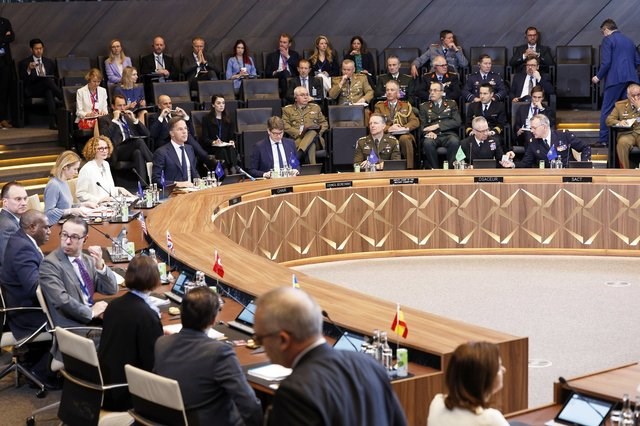
European Union foreign policy chief Kaja Kallas, third left, attends a meeting of the North Atlantic Council in foreign ministers format at NATO headquarters in Brussels, Friday, April 4, 2025. (AP Photo/Geert Vanden Wijngaert)
Republished April 04, 2025 - 4:43 AM
Original Publication Date April 04, 2025 - 3:31 AM
BRUSSELS (AP) — European NATO allies and Canada on Friday said they are willing to ramp up defense spending but are cool on U.S demands for the size of their military budgets, particularly given President Donald Trump’s readiness to draw closer to Russian leader Vladimir Putin.
U.S. allies have spent billions of dollars more on defense since Putin ordered a full-scale invasion of Ukraine three years ago, but almost a third of them still do not meet NATO’s target of at least 2% of their gross domestic product.
Trump has said that U.S. allies should commit to spending at least 5%, but that would require investment at an unprecedented scale. According to NATO figures, the U.S. was projected to have spent 3.38% last year, the only ally whose spending has dropped over the last decade.
“It is important that we all agree that Russia is a threat. If not, I don’t know why we should always increase more and more defense spending,” Canada's Foreign Minister Melanie Joly told reporters at NATO headquarters in Brussels.
At a summit last year, NATO leaders said Russia "remains the most significant and direct threat to Allies’ security.”
Trump’s public rehabilitation of Putin, who had become an international pariah indicted for war crimes, has disturbed U.S. allies, and they believe the decision to rule out NATO membership for Ukraine weakened Kyiv’s hand at the negotiating table before peace talks have even begun.
Beyond that, Europe and Canada were alarmed last month when the United States split with European allies by refusing to blame Russia for its invasion of Ukraine in votes on three U.N. resolutions seeking an end to the three-year war.
U.S. Secretary of State Marco Rubio said Washington is not insisting that its allies hit the 5% spending target overnight, but “we think that’s what NATO allies need to be spending for NATO to face the threats that itself has identified and articulated.”
Rubio said that the extra spending is required to beef up military capabilities.
“We are as involved in NATO today as we have ever been, and we intend to continue to be. But it has to be a real alliance. And that means that our alliance partners have to increase their own capabilities,” he said.
Asked whether the U.S. would also match the 5% target, Rubio said: “Sure. We’re heading there now.”
French Foreign Minister Jean-Noel Barrot said that his country has set itself an “objective of 3%-3.5%, and we are preparing to reach 3%-3.5%, which is about the level of American defense spending.” France was estimated to be spending 2.06% last year.
He said new funds should be spent on European rather than American equipment. In recent years, European allies placed around two-thirds of their equipment orders with U.S. defense companies.
Norwegian Foreign Minister Espen Barth Eide said that NATO members are working on setting a new spending target, to be announced at the next summit in June.
But he said that “5% is of course much more than the U.S. itself spends and it’s a very high ambition and we are not ready to commit to a number at this time. Just as it’s important to spend more, it’s also important to spend more smartly.”
News from © The Associated Press, 2025